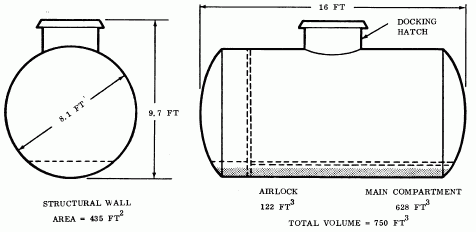
Home - Search - Browse - Alphabetic Index: 0- 1- 2- 3- 4- 5- 6- 7- 8- 9
A- B- C- D- E- F- G- H- I- J- K- L- M- N- O- P- Q- R- S- T- U- V- W- X- Y- Z
Apollo ELS

Apollo ELS
Apollo Early Lunar Shelter
AKA: Early Lunar Shelter. Status: Cancelled 1968.
The study was an evaluation of configurations suitable for use with LM Truck capability (4700 kg).
The primary objective was the evaluation and conceptual design of two-man lunar shelters for comparison with competing concepts such as the LM Shelter. This was later expanded to include evaluation of three-man shelters. Stay-time capabilities were evaluated in terms of crew size, and duty cycles with and without EVA activity.
The EVA duty cycle consisted of 9 hours/day: 6 hours (one man) on a "Local Scientific Survey Module" (LSSM) and a non-concurrent 3 hour EVA on foot in the ELS vicinity. Based on the above, expendable consumption rates were established for crew metabolism, environmental control and life support (EC/LSS), electrical power supply (EPS) and fluid storage.
It was concluded that a minimum design volume of 14 m3 was desirable for a two man, 14 day mission. Final designs were based on a 21 m3 volume. Basic shelter equipment included rechargeable portable life support systems (PLSS) (3 per man), fuel cells for EPS, cryogenic supercritical storage for fuel cell reactants and life support gases, and Li0H for C02 removal.
The study indicated a stay time capability of 50 days for two men within the 4700 kg constraint. Of this 787 man-hours would be available for scientific activities, and 450 man-hours of that for surface studies. A 1578 kg scientific payload could be accommodated, with 600 kW-hours of electricity available for scientific experiments. The ELS could conduct a 912 km lunar surface traverse used together with an LSSM. Capabilities included the ability to deploy scientific stations at various surface points and drill 30 m boreholes for subsurface studies.
With a three-man crew total stay-time would be reduced to 43 days, but man-hours of scientific activities would be increased to 1,050. A two-man crew on an astronomy mission with an OAP telescope could remain on the surface for 66 days. Mass breakdown for the 3-man shelter, 43-day scenario was as follows:
Fixed Equipment
- Structure: 610 kg
- EPS: 338 kg
- Fluid storage: 283 kg
- EC/LSS: 317 kg
- Crew provisions: 236 kg
- Astrionics: 109 kg
- Scientific Equipment: 1573 kg
- Subtotal: 3467 kg
Expendables
- Food: 111 kg
- Water: 103 kg
- PLSS Canisters: 269 kg
- High-pressure oxygen: 57 kg
- Cryogenic oxygen: 551 kg
- Hydrogen: 60 kg
- Personal hygiene/waste management supplies: 53 kg
- Subtotal: 1203 kg
Total: 4670 kg
Family: Lunar Habitats, Moon. Country: USA. Spacecraft: ALSS Lunar Base. Agency: NASA, AiResearch. Bibliography: 1993.
Back to top of page
Home - Search - Browse - Alphabetic Index: 0- 1- 2- 3- 4- 5- 6- 7- 8- 9
A- B- C- D- E- F- G- H- I- J- K- L- M- N- O- P- Q- R- S- T- U- V- W- X- Y- Z
© 1997-2019 Mark Wade - Contact
© / Conditions for Use